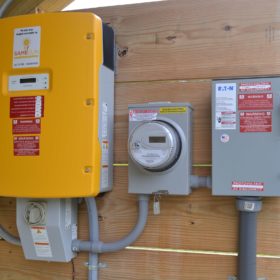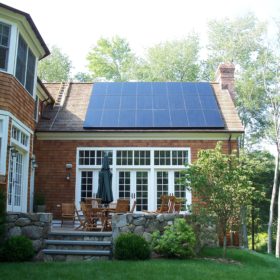The Center for Biological Diversity, Protect Our Communities Foundation and the Environmental Working Group appealed the California Public Utilities Commission’s (CPUC) decision to slash compensation to rooftop solar customers. The appeal is based on the groups’ belief that commission’s decision will harm the ability of environmental justice communities to benefit from solar energy.
In December the CPUC voted unanimously to approve Net Energy Metering 3.0 (NEM), slashing payments by 75% for excess solar production sent to the grid. CPUC voted to cut the average export rate in California from $0.30 per kWh to $0.08 per kWh, making the cuts effective on April 15, 2023. During the vote, the Commission said the balancing of costs and benefits continue to be “quite generous” under the decision.
“California is drowning in climate-driven deluges, and we have to make it easier for communities to embrace rooftop solar to survive the climate emergency,” said Roger Lin, an attorney at the Center for Biological Diversity. “By slashing the net metering program, state regulators made it even harder for environmental justice communities to get solar. We’re appealing because this flies in the face of the commission’s mandate to ensure that rooftop solar is accessible to low-income Californians.”
The groups believe the decision threatens the growing rooftop solar market and puts affordable and resilient renewable energy out of reach for most communities.
“California’s private utilities have been relentless opponents of rooftop solar for many years, because it undercuts the golden goose — new high-profit transmission line construction. They have convinced regulators of the alchemy that they are protecting the interests of lower-income customers — and not shareholder interests — by devaluing rooftop solar,” said Bill Powers, an expert witness in the proceeding and a board member of the Protect Our Communities Foundation.
The appeal says the commission should redo its analysis because regulators devalued rooftop solar based on flawed modeling that ignored net metering’s benefits to environmental justice communities. Those benefits include decreasing the state’s dependence on fossil fuels and providing local economic benefits, including new jobs. The commission also failed to analyze non-solar customer bills and ignored or underestimated harms from fossil fuel energy, particularly to low-income communities and communities of color.
“By making residential solar economically untenable for millions of working families, the CPUC has sidelined the only competition the big utilities face. It will allow PG&E and the other power companies to keep wasting ratepayer money on misguided, high-cost infrastructure investments,” said Ken Cook, president of the Environmental Working Group Ken Cook. “The CPUC needs a reset to fit an emerging new world of electric power. We now have strong competition for utilities from distributed solar, battery storage and microgrids, a technological and economic transformation the likes of which we haven’t seen in more than 100 years.”
The groups noted that the commission also abandoned a $600 million equity fund aimed at getting more clean renewables to low-income communities. Regulators claimed the state’s battery storage fund would achieve the same result, but Gov. Gavin Newsom recently cut that fund by 30%.
Opposition to the commission’s decision is widespread. More than 125 California and national climate and equity groups representing millions of people previously called on the governor’s office to reject the commission’s flawed analysis and maintain the state’s solar credit to grow rooftop solar in environmental justice communities. Bernadette Del Chiaro, executive director, California Solar and Storage Association called the NEM 3.0 decision a “step backwards”. “It is a dark day in California when the utility regulators try to block out the sun,” Del Chiaro said.
This content is protected by copyright and may not be reused. If you want to cooperate with us and would like to reuse some of our content, please contact: editors@pv-magazine.com.









In the letter to Governor Newsom from 129 California and national organizations: . . . .
“…instead of studying actual utility bills, the CPUC bases its “cost shift” assertion on
deeply flawed modeling tools that entirely ignore certain significant benefits of NEM to
California DACs and the enormous harms (economic and otherwise) of continued reliance on
fossil fuels. Specifically, the flawed modeling tools ignore or underestimate:
• The significant reduction in greenhouse gas emissions from not having to operate or
build fossil fuel infrastructure that the NEM program displaces, and the disproportionate
harms that climate-induced disasters and the climate emergency impose on DACs [ disadvantaged communities].
LETTER FROM 125+ ORGANIZATIONS URGING CALIFORNIA’S GOVERNOR Page 2 of 14
TO STAND UP FOR ROOFTOP SOLAR & EQUITY IN NEM PROCEEDING September 12, 2022
• The public health benefits of fewer fossil-fuel power plants in DACs. This includes
the significant, disproportionate and cumulative costs of criteria, toxic, and water
pollutants on DAC residents who live, work, or play around fossil fuel extraction and
generation infrastructure.
• The significant decrease in transmission and distribution costs that the NEM
program saves all ratepayers. For example in 2018 alone, the California Independent
Systems Operator, citing increased rooftop solar and energy efficiency, canceled 20
transmission projects at a $2.6 billion savings to all ratepayers.
• The increased electricity system reliability and resiliency in DACs that NEM provides
as a distributed, decentralized power system. This includes the public health and safety
benefits of stopping power shutoffs.
• The avoided environmental and land use harms from fossil fuel plants and badly sited utility-scale solar and wind projects, including significant impacts to biodiversity,
habitats and species, and the elimination of natural carbon sinks.
• The significant costs of utility-caused wildfire mitigation, such as the costs for
undergrounding of transmission lines and associated power shutoffs that the NEM
program saves all ratepayers.
• The local economic and job benefits that NEM creates, including local clean energy
installation jobs which are more numerous than utility-scale clean energy jobs and fossil
fuel jobs.”
How do you get this website not to remove line-feed/carriage returns (new paragraph) symbols from your text? It removes them and jams everything together.
The group of people most hurt by the higher costs are the very people the Utilities said they were trying to help because of cost shift when the poor end up paying more for all services they need because the savings will disappear. The CPUC gave absolutely nothing to the poor ratepayers or help them own solar panels of their own. The Robin Hood CARE program will still take money from the middle-class ratepayers and give it to the qualified low-income ratepayers. All the extra money goes directly to the stockholders, management and labor at the utilities and no financial relief at all to rate payers. This is why the big utilities paid out close to 2 million collars in attorney’s fees, publications and disinformation about NEM3.0 before it was passed by the CPUC.
There appears to be so much corruption that sometimes I feel like I’m living in a 3rd world country. What is Governor Newsom doing about this? Anything but lip service?
I believe the only way forward would be voter referendum or a cease and desist order for NEM 3 until a class action lawsuit is completed. The California Private Utility Commission did not listen to the vast majority of commenters, Scientific papers, experts, or voters. It refused to step back from the utilities hype and falsehoods. There really should be a criminal investigation of their committee. Amazing how right after NEM3 was approved rates shot up making all the rhetoric spouted invalid and based on nominal rates that are now $0.40 to $0.84 per kwhr. In the summertime NEM3 reimbursement will be one tenth of what it reasonable. TOU plans are bad enough but NEM3 just puts profits into the utilities pockets while increasing costs to ratepayers.
The passing of NEM 3.0 will now require battery storage to be installed on all future PV systems to create a financial benefit for installing solar. However, expensive battery systems push up monthly payments on solar loans and leases beyond what most homeowners currently spend remaining with the grid. Low-income households no longer have a choice to save with solar. Good job CPUC!
I used 80 Deep Cycle Marine/RV batteries on my off-grid system and that cost, with copper wire, terminals and charge controllers was $10.000.00 where the same sized lithium battery system would have cost $28,000.00 plus installation costs. The weight limits imposed by electric vehicle do not apply to home installations since the batteries do not need to be pulled around with a vehicle but are static in an outside battery shack in the back yard or in the garage. Although the lead acid batteries have a 6-year life, they get a faster payback before the next battery swap out and will last over 2 additional swap outs 18 years where lithium only will last 12 years. Lower battery cost, non-flammable lead acid is the way to go both in safety and in overall costs until lithium prices drop by 60%. A Tesla Power Wall should cost no more than $3,000.00 to match the cost of lead acid batteries in a system.
Sorry Edward but I disagree with your Pb vs. Li cost comparison. For ~ $8,000 total, I built a complete solar system which includes a 14.3KWh Li battery, 4,500W of solar panels, and 2 combo inverter/chargers which provide 13KW split phase 120V/240V power for my entire home. My home is totally electric, including heating/cooling via heat pump except for one pellet stove which I use during cold cloudy weather. The Li battery, including the BMS was ~ $2,500. This was built from sixteen 280AH EVE LiFePO4 cells. At one cycle per day (going from approx 100% to 30% state of charge), with a cycle life of 6,000 cycles to 80% remaining capacity, this equates to 16.4 years. And that 16.4 year life is actually specified for 100% to 0% SOC so I’m treating my battery more gently than that. Therefore, it’s highly likely I won’t have to replace my battery for 10 years – to be very conservative. On top of that, the LiFePO4 cells are very safe, require no maintenance, and do not leak fumes or corrode the terminals. Additionally, you can draw the full 1C current from them CONTINUOUSLY without any chance of overheating as well as charge at the full 1C rate CONTINUOUSLY. That’s 280A continuous if you need it. So far, my highest continuous current requirement has been when the water heater, central AC, oven, and lights are all running which has been around 260A. Obviously, you do your cooking, dish washing, and clothes washing/drying during the daylight hours so the panels are supplying power along with the battery when needed. After those chores are done, the panels charge the battery back to 100% before sundown. I’m retired so this works out well for me. A larger battery may be required for people who work during the day since, except for weekends, they’ll probably being using most of the power in the evening.
While it would still be a disaster to “need” battery storage to make NEM3 viable, the fact of the matter is that the amount of battery storage needed would be insane. So from my perspective, adding battery storage is NOT the answer here. It would be OK with partial electrification, but not with full electrification where heat is included. I know this because I’m living it. I make more energy via PV panels than I use on a yearly basis, but when I’m making heat on the cold, cloudy days when I can only generate ~ 2 kWh per day…. and then also need to charge my car…. well there’s just no practical amount of battery storage that I can have here to offset that.
Why is electricity more valuable to the utilities during high demand when they are only willing to pay me a paltry amount no matter when I generate it for them to sell to others? THEY get to make a profit on selling energy? But I’m not allowed to?
Forgot to add in my last comment that I bought used 250W Canadian Solar panels from SanTan Solar. They state that these are 8 to 10 years old. My testing shows that 18 of them have been able to produce slightly over 4KW (mid summer). So they’re producing an average of 222W which is 89% of what new ones would do and the degradation equates to about a 10 year age. At $77/222W = 35 cents/watt, and with another 20 years of life left (80% of output when new), they seem to be a good deal compared to buying new. Also, there was no sales tax on the used panels. But you cannot take the federal or state tax incentives on used panels but you can take it on everything thing else in the system that was purchased new. So 30% off of all the new items plus substantially more due to state and local incentives.
they want us to use batteries so what about our land fills in 20 yrs if everyone has to have a battery really lets get together and kick all these people out of office